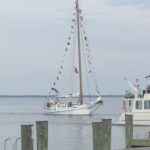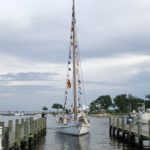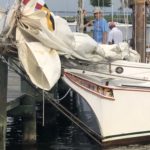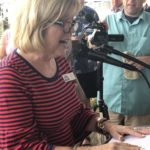Last night around 630pm, if you heard cannon fire and thought that Navy might be celebrating a touchdown–it’d be understandable, but mistaken! The three volleys of cannon fire were celebrating the arrival of the Wilma Lee to the Annapolis Maritime Museum and her now permanent berth.

Wilma Lee was “rescued” from Ocrakoke, NC when the non-profit, Okracoke Alive was unable to keep up on the maintenance of the 75′ boat. The Annapolis Maritime Museum seized the opportunity, formed a committee headed by former President Buck Buchanan who sailed on her as she pulled into her slip last night before a crowd of several hundred AMM members sipping champagne and cheering.
Alice Estrada, the Executive Director of the museum addressed the crowd with two big announcements. First, an anonymous donor approached her at the party and agreed to fund the acquisition of the Wilma Lee in it’s entirety. And second, that yesterday, DNR advised her that they were offering a $500,000 grant for a shoreline and wetland restoration project at the museum’s campus at the Ellen O. Moyer Back Creek Nature Preserve.
The Wilma Lee was built in 1940 on the Maryland shore by the well known boatbuilder Bronza Parks. It is one of the younger boats in the extant fleet of around thirty skipjacks. Over the years, about 800 of these boats had sailed the oyster-laden waters along the Maryland, Virginia and Carolina shores, though today only six are still used for oyster dredging.
The Wilma Lee is 47 feet on the deck, almost 75 feet overall, including the bowsprit and the davit. She is sloop-rigged with a centerboard, 16 feet at the beam, displacing 20 tons. Her mast rises nearly 65 feet above the water line. She is a shallow draft boat, built with 2 1/2″ thick plank on frame construction. With the center board down, she draws around six feet of water and half that with the centerboard up. Her boom is almost 45 feet long, making for a sail area, including the jib, of over 1,700 square feet of canvas.
The Annapolis Maritime Museum plans to use the boat for education, event rentals, and special sightseeing and educational sailings. The first order of business is to get her coast Guard Certified for passengers, and then she will need a good amount of maintenance and ongoing TLC–she is a wooden boat after all! Please stop by the AMM and see their new addition and all of the programs they offer!
Need to learn more about the Annapolis Maritime Museum? Here’s your link!
FULL HISTORY FROM LAST SKIPJACKS
In 1940, fifteen years before he built Rosie Parks, Martha Lewis and Lady Katie, Bronza Parks built his first skipjack. Asbury Lewis had lost his boat in a storm and didn’t have the money to buy another. Asbury’s sister, Katie, was Bronza’s wife. Orville Parks had Bronza, his brother, build the skipjack for Asbury to sail, while Orville would keep sailing his own skipjack, Joy Parks. Wilma Lee displays the unusual fore-and-aft bottom planking at the stern that builder Tom Young had used on Joy Parks, indicating that Bronza probably used Young’s design as a model for his own skipjacks.
Orville sold half ownership in Wilma Lee to Asbury, creating a partnership from which Orville would net half the owner’s share of income from the new boat, while still taking home the owner’s and captain’s shares from Joy Parks. They jointly named the skipjack—”Wilma” for Orville’s older daughter and “Lee” for Asbury’s granddaughter, Barbara Lee. The original trailboards were misspelled “Wilmer Lee.” Her first correctly spelled trailboards are preserved by the Calvert Marine Museum at Solomons Island, Maryland.
Orville and Asbury had an agreement that the one who died first would make payment to the other’s widow to allow the survivor to own the boat outright. Asbury dropped dead on his boat in the summer of 1962 and Orville fulfilled the pact, eventually selling Wilma Lee to Bronza’s son-in-law, Ralph L. Ruark, who continued to sail her out of Wingate. After the Deal Island races began in 1960, Ruark sailed Wilma Lee to back-to-back wins in 1963 and 1964, with another victory in 1977.
Ruark began having health problems and sold Wilma Lee to Robert Wilson in the late 1980s. Wilson previously owned Elsworth and described Wilma Lee as a much easier boat to sail. Ralph Ruark’s daughter, Patti Ruark Hall, recalled Wilson running the boat into the drawbridge at Tilghman Island, breaking the mast. “He and his brother both jumped overboard…they were ok…but lots of damage to Wilma Lee,” she said. “He called my Dad to tell him…He said, ‘I know you will hear about it so you might as well hear first hand.'”
Wilson and Wilma Lee survived another close call. They were participating in a Maryland state program that puts skipjacks to work after their dredging season ends by paying them to transfer seed oysters—spat—from protected areas to exhausted oyster beds. Aging boats that are accustomed to hauling no more than the 150-bushel limit can be piled with up to a thousand bushels of spat on deck, contained from spilling over the low rails by plywood boards.
Wilma Lee was piled high one spring day in 1992 when the weather turned foul. A sudden wind shift caught her boom and caused a jibe, where the boat’s stern passes through the eye of the wind. An unplanned jibe in a skipjack can be a treacherous move. Wilma Lee‘s 52-foot boom whipped from one side of the boat to the other, knocking down Wilson and causing the boat to heel over perilously before he was able to regain control.
There apparently were renovations done during Robbie Wilson’s ownership. A photo taken during that time reportedly shows a new modern stainless steel wheel for the helm. The history of Skipjack Nathan of Dorchester, built 1992-94, records that she received Wilma Lee‘s old wheel and gearbox, although the gearbox needed to be re-engineered to adapt it from Wilma Lee‘s spud rudder (below the hull) to Nathan‘s barn-door rudder (behind the stern) configuation.
Herb Carden purchased the boat in 1995 and took her across the Chesapeake Bay to his home in Kinsale, Virginia. He hauled her out in 1997 for repairs and ended up almost fully rebuilding Wilma Lee over the next five years. About all that was left of the original wood was the stem, mast step and keelson. Shipwright John Morganthaler oversaw the reconstruction. “We hauled it and the transom about fell off,” he recalled.
Chairman of the Board of Potomac Supply Corporation, a lumber company, Carden had access to plenty of materials for the job. The company pressure treated all the wood and only stainless steel, Monel or silicon bronze fasteners were used. “I wanted to build it so it would look good and last for a long time,” said Carden.
At her slip on Carden’s waterfront estate, Wilma Lee was a pampered lady of leisure. She has a well appointed galley with stove and microwave. Her deck was fiberglassed for long wear and sure footing. Carden installed twin 150-horsepower diesel inboard engines, along with a pair of 250-gallon fuel tanks to feed them. He reported being able to get her up to 12 or 13 knots, an impressive speed for boats that usually are considered moving right along at about 8 or 9 knots. Under Carden’s ownership, she raced under sail in the Turkey Shoot Regatta on the Rappahannock River, but no longer dredged.
In early 2012, though, Carden sent the lady of leisure back to work, donating the boat to the nonprofit organization Ocracoke Alive. The boat had a nail-biting trip down the Intracoastal Waterway to Ocracoke, North Carolina, barely making it under several of the bridges. When the mast needed to be removed as part of a Coast Guard inspection, the organization took the opportunity to trim a foot from the top of the mast to make any future waterway trips less stressful.
The changes necessary to get her passenger vessel certification from the Coast Guard took until October 2012. Wilma Lee now is licensed to carry up to 42 passengers. She had a challenging 2013 season, as problems cropped up and glitches got worked out, so everyone was looking forward to the 2014 season. However, the Fourth of July brought unexpected fireworks as Hurricane Arthur struck. $70,000 later, with a new boom, a new set of sails and reconstructed stem, Wilma Lee finally had a good season in 2015 in her new life as a tourism and educational vessel.
However, the struggles to keep her safe on the Outer Banks and find available captains led Ocracoke Alive to begin searching for a new owner for the boat in 2018. We are happy to report that the Annapolis Maritime Museum acquired her $60,000, returning her to the Chesapeake Bay to sail out of the museum’s two campuses on Back Creek.
















































